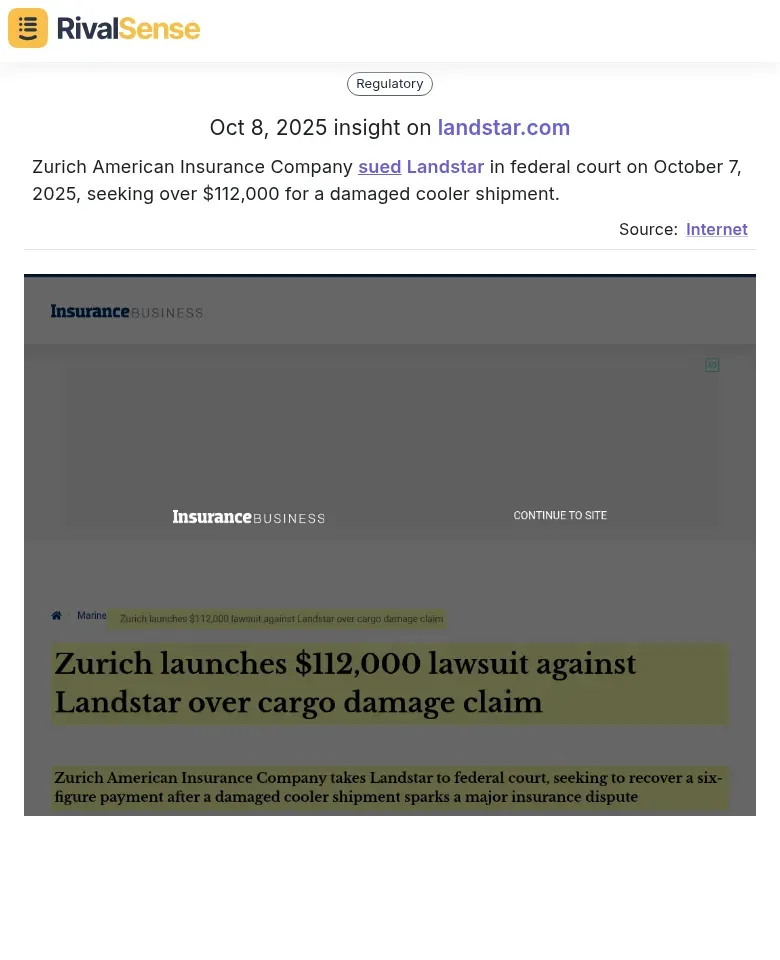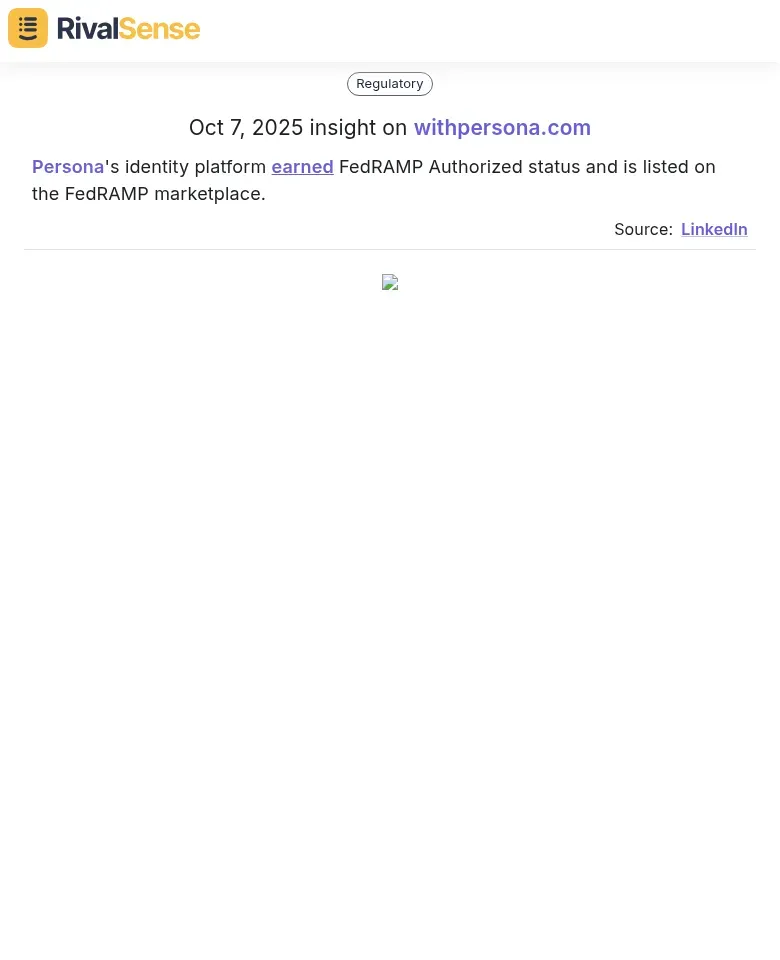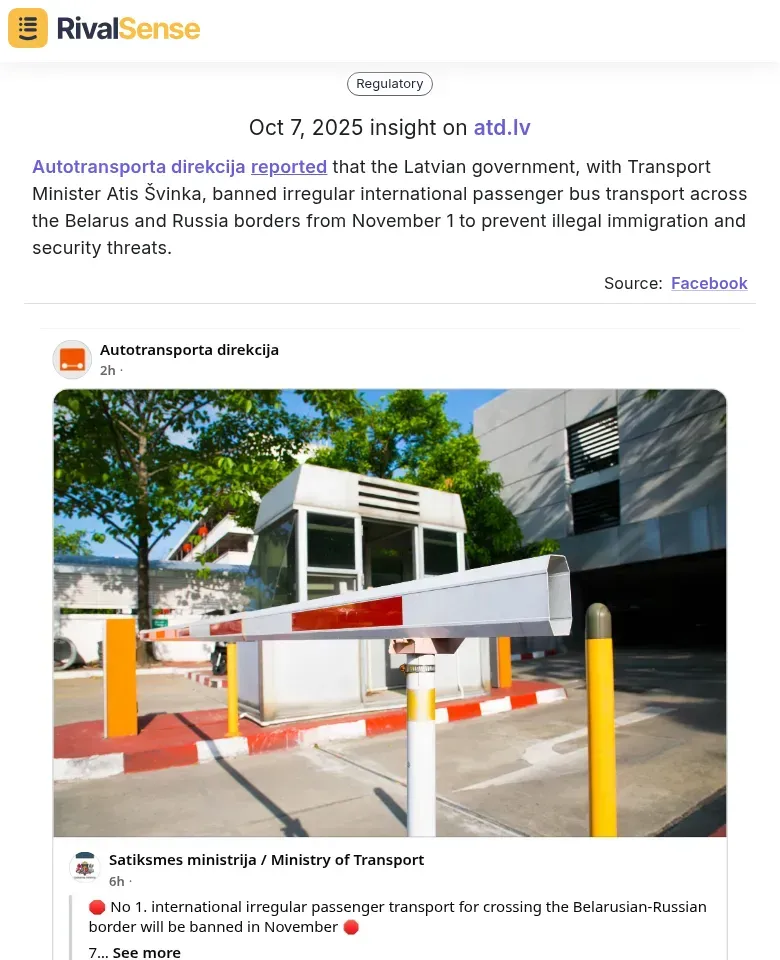Actionable Guide to Regulatory Competitor Insights for Key Accounts
Regulatory competitor insights involve systematically tracking and analyzing how competitors navigate regulatory landscapes, a crucial element for key account management in B2B sectors. By monitoring competitors' regulatory filings, compliance updates, and enforcement actions, companies can anticipate market shifts—such as new product approvals or penalties—that impact client relationships and revenue. For example, if a rival faces a regulatory setback, it may create opportunities to secure their key accounts by highlighting your compliance strengths. This foresight helps mitigate compliance risks and align strategies with evolving standards.
To leverage these insights, start by identifying key regulatory bodies and tracking public databases for competitor actions. Use tools like RivalSense to automate monitoring and set alerts for significant changes. Incorporate findings into account planning: assess risks, update value propositions, and train teams on compliance differentiators. Practical steps include creating a regulatory watchlist, reviewing quarterly reports, and engaging legal experts to interpret complex rulings. By embedding regulatory insights into decision-making, B2B leaders can protect key accounts, seize competitive advantages, and drive sustainable growth.
Learning from Legal and Compliance Actions
Legal disputes reveal critical industry standards and liability patterns that can directly affect your business strategy. For example, analyzing recent court cases in your sector helps identify common compliance failures and enforcement trends, allowing you to anticipate regulatory priorities and adjust risk management approaches. This proactive stance ensures you're not caught off guard by similar issues.
Take the recent case tracked by RivalSense: Zurich American Insurance Company sued Landstar in federal court on October 7, 2025, seeking over $112,000 for a damaged cooler shipment.  This type of insight is valuable because it highlights real-world liability risks and compliance gaps in logistics or insurance sectors, enabling you to reinforce contracts and avoid costly disputes with key accounts.
This type of insight is valuable because it highlights real-world liability risks and compliance gaps in logistics or insurance sectors, enabling you to reinforce contracts and avoid costly disputes with key accounts.
Practical steps:
- Monitor industry litigation databases for emerging disputes
- Extract key contractual clauses that failed or succeeded in court
- Document enforcement patterns to predict regulatory focus areas
- Implement contractual safeguards based on litigation lessons
Checklist for action:
- [ ] Review 3-5 recent industry court cases quarterly
- [ ] Identify recurring compliance failure points
- [ ] Update contracts with protective clauses from successful defenses
- [ ] Train teams on litigation-derived risk scenarios
💡 Tip: Focus on cases involving companies similar to your key accounts to extract directly applicable insights.
Gaining Insights from Certification and Authorization Milestones
Monitoring certifications like FedRAMP, SOC 2, or ISO 27001 reveals competitors' expansion into regulated markets and their commitment to compliance standards. For instance, when a competitor achieves a major authorization, it signals their strategic moves, allowing you to anticipate shifts in market dynamics and adjust your approach accordingly. This intelligence is essential for staying ahead in competitive bidding and client retention.
Consider this RivalSense insight: Persona's identity platform earned FedRAMP Authorized status and is listed on the FedRAMP marketplace.  Tracking such milestones is valuable because it alerts you to competitors' entry into government or high-security sectors, enabling you to reassess your positioning and accelerate your own certification efforts to secure key accounts.
Tracking such milestones is valuable because it alerts you to competitors' entry into government or high-security sectors, enabling you to reassess your positioning and accelerate your own certification efforts to secure key accounts.
Authorization status heavily influences competitive positioning and trust with key accounts. Clients in regulated industries prioritize vendors with proven compliance, viewing certifications as trust signals. If a rival gains a key certification, they may secure accounts you're targeting. Assess how this impacts your positioning—perhaps by accelerating your own certification efforts or highlighting other differentiators.
Leverage similar certifications for market differentiation. If competitors lack certifications you hold, emphasize this in sales pitches to key accounts. Use a checklist: identify relevant certifications for your market, monitor competitors' progress, benchmark your status, and communicate advantages. This proactive approach helps you seize opportunities and build credibility in regulated sectors.
Understanding Government Regulations and Policy Changes
Government regulations and policy changes can dramatically reshape competitive landscapes overnight, making it vital to stay informed about new mandates and bans. Tracking these shifts helps you foresee operational impacts on competitors and identify opportunities to pivot or reinforce your strategies in response to evolving rules.
For example, RivalSense recently highlighted that Autotransporta direkcija reported the Latvian government, with Transport Minister Atis Švinka, banned irregular international passenger bus transport across the Belarus and Russia borders from November 1 to prevent illegal immigration and security threats.  This insight is valuable because it demonstrates how government actions can disrupt supply chains or market access, allowing you to anticipate competitor challenges and adapt your key account plans to mitigate similar risks.
This insight is valuable because it demonstrates how government actions can disrupt supply chains or market access, allowing you to anticipate competitor challenges and adapt your key account plans to mitigate similar risks.
Analyze regulatory motives: security concerns often drive tech restrictions, while immigration policies affect talent pools. Understanding these drivers helps predict future industry rules. Use policy examples to develop proactive strategies. Create a regulatory monitoring checklist: 1) Subscribe to government agency alerts, 2) Track competitor compliance filings, 3) Analyze policy impact on key accounts. For instance, if a competitor faces new environmental regulations, anticipate their cost increases and position your solution as compliant. Adapt by diversifying supply chains or adjusting product features ahead of mandates. This approach turns regulatory risks into competitive advantages, ensuring your key account strategies stay resilient and compliant.
Integrating Insights into Key Account Strategy
Integrating regulatory insights into your key account strategy transforms raw data into competitive advantage by aligning your approach with real-time market dynamics. Start by building holistic competitor profiles that combine legal compliance records, certification status, and regulatory track history to identify vulnerabilities and strengths you can leverage.
For example, if a competitor faces pending FDA audits, this creates vulnerability you can exploit with healthcare clients concerned about supply chain reliability. Develop tailored approaches by mapping competitors' regulatory strengths and weaknesses to each key account's priorities, such as targeting rivals lacking ISO 14001 if a client values sustainability.
Implement continuous monitoring systems with automated alerts for competitor regulatory changes, certification renewals, and compliance violations. Use a simple checklist to stay organized:
- [ ] Weekly regulatory database scans
- [ ] Monthly certification status reviews
- [ ] Quarterly compliance risk assessments
- [ ] Real-time alert triggers for major violations
🚀 Practical tip: Assign regulatory intelligence ownership within your account teams. When a competitor's product certification expires, immediately engage affected accounts with compliance-assured alternatives to turn insights into revenue opportunities.
Best Practices for Effective Regulatory Insight Tracking
Establishing systematic processes for regulatory intelligence ensures that insights are consistently captured and acted upon across your organization. Begin by creating a centralized repository for all competitor regulatory filings, approvals, and compliance updates to facilitate easy access and analysis for decision-makers.
Assign dedicated team members to monitor key regulatory bodies and set up automated alerts for competitor activities using tools like RivalSense, which can track everything from FDA submissions to patent filings in real-time. Develop a standardized analysis framework that categorizes insights by impact level and business relevance, making it easier to prioritize actions.
Leverage automation technologies to streamline tracking efforts and reduce manual workload. Implement AI-powered tools that scan regulatory databases, news sources, and competitor websites for relevant updates, and set up dashboards to visualize competitor regulatory timelines and approval patterns for quick insights.
Foster cross-functional collaboration through regular insight-sharing sessions between regulatory, marketing, and strategy teams. Create action-oriented reports that translate regulatory findings into specific business recommendations, such as adjusting product launch timelines based on competitor approvals or identifying market gaps revealed by regulatory patterns. Develop a feedback loop where field teams provide real-world observations to refine your tracking accuracy.
Take Action with RivalSense
Ready to transform your regulatory competitor insights into actionable strategies? Try RivalSense for free at https://rivalsense.co/ to automate tracking of competitor product launches, pricing updates, event participations, and more—delivered in a weekly email report. Get your first competitor report today and start gaining the edge you need to protect and grow your key accounts!
📚 Read more
👉 How SentinelOne's Event Strategy Offers Valuable Competitor Insights
👉 Key Account Management Software in 2025: The Ultimate Guide for Business Leaders
👉 Free Competitor Analysis Tools to Boost B2B Productivity
👉 How VEED's AI Launch Drove a Competitor's Strategic Pivot
👉 Instagram Competitor Insights: A Checklist for Employee Benefits Analysis
